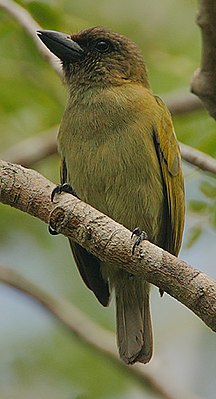Olive beard bird
| Olive beard bird | ||||||||||||
|---|---|---|---|---|---|---|---|---|---|---|---|---|

Olive whisker ( Stactolaema olivacea ) |
||||||||||||
| Systematics | ||||||||||||
|
||||||||||||
| Scientific name | ||||||||||||
| Stactolaema olivacea | ||||||||||||
| ( Shelley , 1880) |
The Olivbartvogel ( stactolaema olivacea ) is a bird art from the family of the African barbets. The species occurs in East Africa south of the equator. Several subspecies are distinguished. The IUCN classifies the olive whiskered bird as not endangered ( least concern ).
Appearance
The males of the nominate form reach a wing length of 8.3 to 9.4 centimeters. The tail length is between 4.4 and 5.1 centimeters. The beak is between 1.7 and 1.9 centimeters long. Females have similar body measurements. As with all Stactolaema species, there is no noticeable sexual dimorphism .
Males and females have a black-brown forehead, the feathers on the sides of the head are gray-black with green tips, the sides of the neck and throat are olive-colored. The top of the body is yellowish green. The control feathers are yellow-green on the upper side, the nibs and the feather edges are black-brown, the feather base is basically a bit lighter and the feather shafts are matt black. On the underside, the control springs are dull yellowish green, the spring shafts pale yellowish.
The chin is black to brown, the throat is olive-gray, the underside of the body is olive-gray from the chest to the belly. The sides of the body up to the flanks and the under tail covers are a little paler yellowish green. The beak is dull black, the featherless skin around the eyes is dull black, the eyes are brown. The legs and feet are black. Young birds are similar to the adult birds, but have an overall duller plumage with less pronounced yellow tones.
There is hardly any possibility of confusion with other species in the area of distribution: Only the bearded bird from the genus of the dwarf bearded must have a comparably green plumage. However, this species has a smaller beak, is much more active and occurs mainly in the undergrowth. The singing of the two species is also very different.
Distribution area
The range of the olive-bearded bird is disjoint . It occurs in Kenya, Tanzania, Malawi, in western Mozambique and in the South African province of Natal . In Kenya and Natal it occurs at sea level, in other regions of its distribution area it lives on high plateaus up to altitudes of a maximum of 2000 meters. In the mountain forests of the Udzungwa Mountains National Park , which extend up to 2400 meters above sea level, the olive-bearded bird has not yet been observed above 1870 meters. Its habitat are moist to dry forests. In its habitat, besides the plain bearded bird, the white-eared bearded bird and the collared bearded bird occur, some of which are in competition with this species and have an influence on the local distribution of the olive -bearded bird.
Way of life
The olive whiskered bird is a socially living bird that occurs in groups of up to eight individuals. The food spectrum consists of fruits and insects. Indigestible kernels and insect components are strangled up again and spat out.
The Olivbartvogel squads defend a territory with blurred borders. The territories can be anywhere from 20 to 25 hectares. Olive whiskers are cave breeders who chop their nesting holes into dead wood. The nesting cavity is up to 60 centimeters deep and is used as a resting place by all adult birds in a federation. During the breeding season, one member of the squad stays near the nesting cavity and defends it against nesting site competitors or breeding parasites such as the small honey indicator and the black throat honey indicator .
The breeding season varies depending on the geographical latitude. The clutch consists of three to six eggs. These have a white, smooth shell. It has not yet been proven whether the helper birds in a troop are also involved in the brood. The breeding season is unknown, the nestling period is around 30 days. The nestlings are initially fed exclusively with insects and later also with fruits.
supporting documents
literature
- Lester L. Short, Jennifer FM Horne: Toucans, Barbets and Honeyguides - Ramphastidae, Capitonidae and Indicatoridae . Oxford University Press, Oxford 2001, ISBN 0-19-854666-1
Individual evidence
- ↑ a b Short et al., P. 146
- ↑ Short et al., P. 147
- ↑ a b Short et al., P. 148
- ↑ Short et al., P. 148 and p. 149
- ↑ Short et al., P. 149
Web links
- Cryptolybia olivacea in the Red List of Threatened Species of the IUCN 2013.2. Listed by: BirdLife International, 2012. Retrieved February 2, 2014.